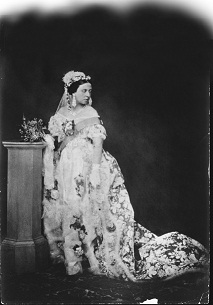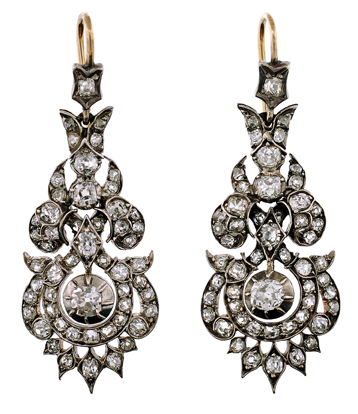Nineteenth–century England had a “royal” connection to the diamond mines of the day, first from India — Queen Victoria was crowned Empress of India in 1876, points out Mary Borchert, gemologist and jewelry historian currently with Antique Jewelry University — and then, in 1867, from South Africa. In fact, “It’s a big reason why there were a lot of diamonds in the jewelry of the Victorian era,” Borchert adds. “The British Empire controlled India, South Africa and Australia, and that’s where all the diamonds were coming from.”
 This larger supply chain of diamonds from the South African “diamond rush” that made their way into the marketplace, says Peter Shemonsky, private jeweler and jewelry historian in San Francisco, California, was coupled with technological advances in diamond cutting, “So you have more diamonds, as well as better-cut and larger diamonds, and this all contributed to a greater demand and popularity for the gemstones.” Moreover, says Shemonsky, “at the same time, new wealth created by the Industrial Revolution established a wealthier upper and middle class. You had a wealthier group of people and more diamonds in the market and one helped propel the other to a certain extent.” Although traditionally it was royalty who wore diamonds, the discovery of the new mines helped filter the glittering stone throughout society.
This larger supply chain of diamonds from the South African “diamond rush” that made their way into the marketplace, says Peter Shemonsky, private jeweler and jewelry historian in San Francisco, California, was coupled with technological advances in diamond cutting, “So you have more diamonds, as well as better-cut and larger diamonds, and this all contributed to a greater demand and popularity for the gemstones.” Moreover, says Shemonsky, “at the same time, new wealth created by the Industrial Revolution established a wealthier upper and middle class. You had a wealthier group of people and more diamonds in the market and one helped propel the other to a certain extent.” Although traditionally it was royalty who wore diamonds, the discovery of the new mines helped filter the glittering stone throughout society.
Design Timeline
Historians generally divide the long reign of Queen Victoria, who ruled from 1837 to 1901, into three broad categories: Early Victorian, 1837-1860; Mid Victorian, 1860-1885 and Late Victorian, 1885-1901. Diamonds, points out Lisa Stockhammer-Mial, president, The Three Graces, an online retailer of fine antique and vintage jewelry, “were mostly produced in the third and final period. Toward the last 20 to 30 years of the century is when you find a great deal of the diamond jewelry.”
 Victorian jewelry of the mid-nineteenth century, from 1850 to 1860s, had a lot of floral motifs, Shemonsky says, “so you get a lot of heavily encrusted diamond pieces in evening wear — big corsage ornaments and big floral bouquets. They were very elaborate ‘confections’ using mostly lots of smaller diamonds to maximize the sparkle.”
Victorian jewelry of the mid-nineteenth century, from 1850 to 1860s, had a lot of floral motifs, Shemonsky says, “so you get a lot of heavily encrusted diamond pieces in evening wear — big corsage ornaments and big floral bouquets. They were very elaborate ‘confections’ using mostly lots of smaller diamonds to maximize the sparkle.”
As you progress through the Victorian era, says Shemonsky, “you go through a series of styles, until you get to the late 1880s and 1890s, when you have what is called the Aesthetic Movement, where people started looking toward a more simplistic, less overtly fussy style. And that is when you start seeing the advent of using larger stones, single stones or just a few stones as the central element in the pieces.”
Styles would keep getting reinvented, Borchert says. “There were periods where they’d do Classical and then Naturalism with leaves and flowers and then there would be some other thing. Then, when Albert died, that was it — Queen Victoria went to black jewelry. But she really set the trends. And she was there so long, she had a big influence.”
People wore a lot of rings, a lot of brooches, always some kind of a necklace, points out Borchert, “although the tiaras and such were usually reserved for an occasion. They put gems in their hair; they had all sorts of earrings — big and long and beautiful waterfalls of diamonds.” They were into talisman shapes, adds Borchert, “four-leaf clovers, little starburst shapes, crescents.” There were often suites, or parures, of various sizes — perhaps a big brooch and earrings, or maybe brooch, necklace, earrings and bracelet.
Setting the Style
Noticeable metalwork tended to be more the norm, says Stockhammer-Mial, “the settings more substantial, with a little more metal showing, and the diamonds generally a little less important, although sometimes you have a showy cluster that’s all about diamonds. The old mine cut stones tend to have a heavier, chunkier, naïve look because they were hand cut, their perimeters squarish or roundish. The open culet of a stone is so prominent in many of the pieces that you get a certain characteristic look of the era.”
According to Shemonsky, “setting diamonds in a white metal goes back to the Renaissance; it was felt it enhanced the whiteness of the stones. But silver is soft and you need a lot of metal to support it. In the nineteenth century, gold was used as the support base with a sheet of silver fused to the top of it in which stones were actually set. And that was given a bright polish so the diamonds and the white metal all played off each other. With the introduction of platinum in the latter half of the century, silver-topped gold was replaced by platinum-topped gold and then, by the early 1900s, all platinum, since the gold undersupport was not needed. The exception is a period in the late 1860s and then again in the 1890s, when it became the fashion to have diamonds set only in gold. So you will find pieces in all gold encrusted with small accent diamonds,” from those periods.
“With the older cut diamonds,” says Gail Brett Levine, executive director, National Association of Jewelry Appraisers, “they’d adhere to the diamond crystal, so the stones were very weighty. Because of the preciousness of the material, they wanted to keep it as close to the rough as possible and facet it minimally, just enough to get some light going through it. The other problem with the jewelry, especially in the early to mid-Victorian era, was the closed mountings, which would deaden the stones.” When they started to open up the back and create the ajouring, says Levine, “they used big thick ugly prongs, and lots of them, to keep big diamonds safe.”
Today’s Appeal
Stockhammer-Mial finds customers like the less dressy look of old mine cuts. “The pronounced settings and the patina even work well with jeans. These can be a bit softer and more versatile for today’s woman than the delicate Edwardian or Art Deco pieces that are so formalized and shimmering. You can even wear several diamond pieces together and it looks fashionable and not overdone.”
Annette Brandt, A. Brandt and Son Antique Jewelry, also sees a preference for the older cuts. “There’s a certain allure to them. The fact that they’re not perfectly faceted just adds more charm and a sense of history.” In terms of what’s selling, Brandt says brooches aren’t as sellable unless they’re also pendants but Riviera necklaces are very popular. “The silver top makes it a little more casual, especially when it takes on a nice patina and darkens.”
Brandt says Victorian jewelry and diamonds “are growing in popularity, especially the rings.” Stockhammer-Mial also finds that “rings are the kings — people are always looking for diamond cluster rings of that period. They love the old mine cuts particularly. After rings in popularity are earrings, necklaces and pendants, then bracelets. I find brooches sell best when they can also be worn as pendants. People also love diamond necklaces and pendants, but with smaller diamonds so they’re wearable for daytime.”
“Generally, Victorian jewelry is still soft,” says Levine, “when you take a look at some of the cameos and the heavy brooches. But the big chunky diamond rings and the Riviera necklaces still go for extraordinary amounts of money, because it’s all about diamonds and demand. The other thing I see is there are a lot more old European and old mine diamonds being certed now, which gives them some respect.”
Because the period encompassed such a great amount of time, there is a lot of Victorian jewelry out there, says Shemonsky. “It can range from a few hundred dollars to many hundreds of thousands of dollars. In terms of the diamond jewelry, single-stone rings or earrings are going to be more valuable than diamond-encrusted pieces in general.
Diamond brooches are not going to be priced in the same way as diamond bracelets with the same amount of diamonds.”
“Don’t expect a Victorian piece to be E color, VVSII or even VVS,” says Stockhammer-Mial. “They weren’t into the 4Cs back then. Almost all the diamonds I see in the marketplace, in general, are I, J, K, or even L or M, and they tend to be SIs.” But one advantage to the period, Stockhammer-Mial says, “is the price point generally can be very reasonable if one is looking for affordable diamond jewelry.”
*Top: Queen Victoria of England at age 36.©Hulton-Deutsch Collecitons/CORBIS
Right: Early Victoria earrings with 53 old mine cute diamonds set in silver-topped 14-karat gold, crica 1850. Photo courtesy A Brandt and Son Antique Jewelry
Article from the Rapaport Magazine - March 2011. To subscribe click here.